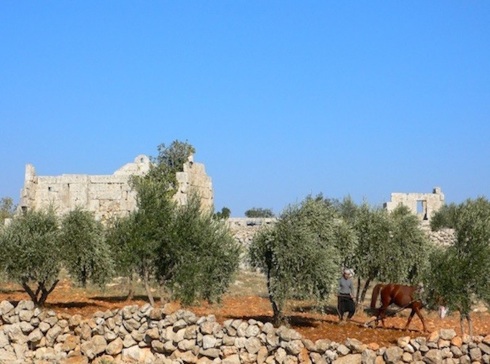Les villages antiques du Nord de la Syrie [ Syrie ]
plan de gestion | management plan
2009-2011 | site inscrit en 2011 | français



Les villages antiques du Nord de la Syrie [ Syrie ]
plan de gestion | management plan
2009-2011 | site inscrit en 2011 | français



EN
The Management Plan – realized under the direction of RC Heritage – is the result of a teamwork to which have actively contributed the DGAM personnel and a group of international and Syrian experts in the fields of cultural tourism, archaeology, heritage law, and park management. This plan – reinforced by an Action Plan submitted in December 2010 – has been included in the Nomination File for the inscription of the Antique Villages to the World Heritage List. The site was listed in June 2011.
Based upon the principles of sustainable development, the Plan aims at balancing preservation and economic development in order to guarantee the contribution of the Limestone Massif region to the social and economic development of the country.
The Plan is both flexible, to adapt itself to the finds of the ongoing archaeological excavations and to the economic dynamics of the region, and strict, to impose the respect of the legal framework protecting the ruins and the landscape from modern encroachments while permitting the sustainable development of the region and its residents.
The reinforcement of the Syrian legal framework has been one of the key issues addressed in the Management Plan. A set of 8 decrees – signed by the Prime Minister – extending the authority of the DGAM from the single archaeological sites to the area of the eight parks composing the cultural landscape of the ancient villages of Northern Syria, has notably been prepared within the framework of this study.
The proposed management system aims at controlling and coordinating (and at directing the implementation) all plans and projects within and around the protected perimeters – both already ongoing and still in the making – according to the provisions of the prime ministerial decrees. This ambitious plan, requiring a continuous and effective coordination among all the stakeholders, is meant to become a practical “tool” directing the sustainable development of the region around its outstanding heritage resources.
Le plan de gestion, réalisé par RC Heritage, est l’aboutissement d’un travail commun effectué avec les cadres de la DGAM et une équipe d’experts syriens et internationaux, dans les domaines du tourisme, de l’archéologie, du droit du patrimoine et de la gestion des parcs naturels. Ce plan, complété par un Plan d’Action au cours de l’année 2010, a été inséré dans le dossier de candidature remis à l’UNESCO / Centre du patrimoine mondial en janvier 2010. Le site a été inscrit en juin 2011.
Le plan vise à parvenir à un équilibre entre conservation et développement économique et touristique, conformément aux principes du tourisme durable, afin que la région du Massif calcaire puisse contribuer au développement social et économique du pays.
Le plan doit pouvoir s’adapter aux résultats des campagnes de fouilles et aux dynamiques économiques du territoire pour garantir, d’une part, que l’ensemble des vestiges à l’intérieur du périmètre protégé ne soit pas endommagé par les constructions et les infrastructures modernes et, d’autre part, que la population de la région puisse vivre et se développer en harmonie avec le paysage environnant.
Afin de rendre possible la candidature des villages antiques du Nord de la Syrie en tant que paysage culturel, il a fallu renforcer le cadre législatif existant par l’approbation de huit décrets du président du Conseil des ministres qui étendent les compétences de la DGAM des seuls sites archéologiques aux territoires définis par les périmètres de chaque parc.
Le système de gestion vise à permettre le contrôle, la coordination et la mise en œuvre de toutes les activités et plans – en cours ou à l’état de projet – qui se déroulent dans le site des villages antiques du Nord de la Syrie et dans ses alentours immédiats, selon le cadre prévu par les décrets de classement.
Ce plan, qui devra être mis en œuvre à travers une coordination constante avec l’ensemble des partenaires concernés, deviendra ainsi, pour la région, un véritable programme de développement durable centré sur sa valeur patrimoniale.
Client
Convention France-Unesco pour le Patrimoine, Ministère de la culture / Ministère des affaires étrangères et européennes, Paris, France
Dates
février 2009 / janvier 2011
Liens | links
Convention France UNESCO / les villages antiques
UNESCO Centre du Patrimoine mondial / Les Villages Antiques
NB: Depuis juin 2013, les six sites du patrimoine mondial de Syrie sont inscrits sur la Liste du patrimoine en péril | Since June 2013, Syria’s six World Heritage sites are placed on the List of World Heritage in Danger
